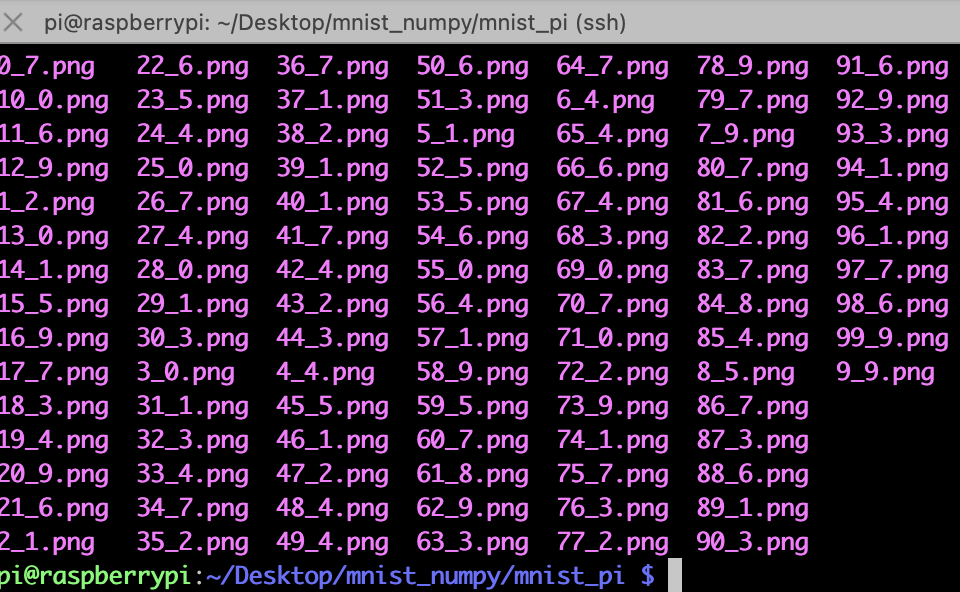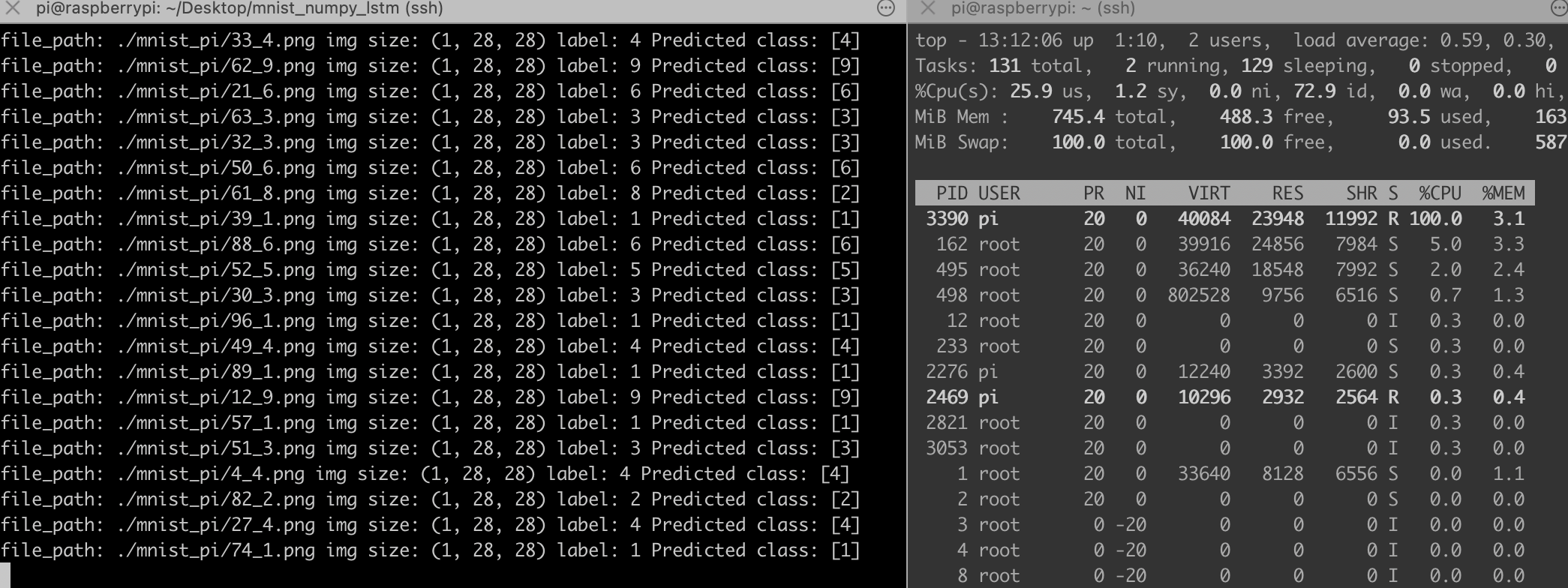在树莓派上实现numpy的LSTM长短期记忆神经网络做图像分类,加载pytorch的模型参数,推理mnist手写数字识别
这几天又在玩树莓派,先是搞了个物联网,又在尝试在树莓派上搞一些简单的神经网络,这次搞得是LSTM识别mnist手写数字识别
训练代码在电脑上,cpu就能训练,很快的:
import torch
import torch.nn as nn
import torchvision
import numpy as np
import os
from PIL import Image # 定义LSTM模型
class LSTMModel(nn.Module):
def __init__(self, input_size, hidden_size, num_layers, num_classes):
super(LSTMModel, self).__init__()
self.hidden_size = hidden_size
self.num_layers = num_layers
self.lstm = nn.LSTM(input_size, hidden_size, num_layers, batch_first=True)
self.fc = nn.Linear(hidden_size, num_classes) def forward(self, x):
h0 = torch.zeros(self.num_layers, x.size(0), self.hidden_size).to(x.device)
c0 = torch.zeros(self.num_layers, x.size(0), self.hidden_size).to(x.device) out, (h_n,c_n) = self.lstm(x, (h0, c0))
out = self.fc(out[:, -1, :])
return out # 设置超参数
input_size = 28
sequence_length = 28
hidden_size = 128
num_layers = 2
num_classes = 10
batch_size = 100
num_epochs = 1
learning_rate = 0.001 # 加载MNIST数据集
train_dataset = torchvision.datasets.MNIST(root='./data', train=True, transform=torchvision.transforms.ToTensor(), download=True)
test_dataset = torchvision.datasets.MNIST(root='./data', train=False, transform=torchvision.transforms.ToTensor()) # 创建数据加载器
train_loader = torch.utils.data.DataLoader(dataset=train_dataset, batch_size=batch_size, shuffle=True)
test_loader = torch.utils.data.DataLoader(dataset=test_dataset, batch_size=batch_size, shuffle=False) # 创建LSTM模型
model = LSTMModel(input_size, hidden_size, num_layers, num_classes) # 定义损失函数和优化器
criterion = nn.CrossEntropyLoss()
optimizer = torch.optim.Adam(model.parameters(), lr=learning_rate) # 训练模型
total_step = len(train_loader)
for epoch in range(num_epochs):
for i, (images, labels) in enumerate(train_loader):
images = images.reshape(-1, sequence_length, input_size)
outputs = model(images)
loss = criterion(outputs, labels) predictions = torch.argmax(outputs,dim=1)
# acc = torch.eq(predictions,labels).sum().item()
# print(acc)
optimizer.zero_grad()
loss.backward()
optimizer.step() if (i + 1) % 100 == 0:
print('Epoch [{}/{}], Step [{}/{}], Loss: {:.4f}'.format(epoch + 1, num_epochs, i + 1, total_step, loss.item())) # 保存模型
torch.save(model.state_dict(), 'model.pth') # 加载模型
model.load_state_dict(torch.load('model.pth'))
with torch.no_grad():
for i, (images, labels) in enumerate(test_loader):
images = images.reshape(-1, sequence_length, input_size)
outputs = model(images)
predictions = torch.argmax(outputs,dim=1)
acc = torch.eq(predictions,labels).sum().item()
print(acc) # folder_path = './mnist_pi' # 替换为图片所在的文件夹路径
# def infer_images_in_folder(folder_path):
# with torch.no_grad():
# for file_name in os.listdir(folder_path):
# file_path = os.path.join(folder_path, file_name)
# if os.path.isfile(file_path) and file_name.endswith(('.jpg', '.jpeg', '.png')):
# image = Image.open(file_path)
# label = file_name.split(".")[0].split("_")[1]
# image = np.array(image)/255.0
# image = np.expand_dims(image,axis=0)
# image= torch.tensor(image).to(torch.float32)
# logits = model(image)
# predicted_class = torch.argmax(logits)
# print("file_path:",file_path,"img size:",image.shape,"label:",label,'Predicted class:', predicted_class)
# break # infer_images_in_folder(folder_path) # 保存模型参数为numpy的数组格式
model_params = {}
# print(list(model.parameters()))
for name, param in model.named_parameters():
model_params[name] = param.detach().numpy()
print(name,param.shape) np.savez('model.npz', **model_params)
然后需要自己在dataset里导出一些图片:我保存在了mnist_pi文件夹下,“_”后面的是标签,主要是在pc端导出保存到树莓派下

树莓派推理端的代码,需要numpy手动重新搭建网络,并且需要手动实现双层的LSTM神经网络,然后加载那些保存的矩阵参数,做矩阵乘法和加法
import numpy as np
import os
from PIL import Image # 加载模型参数
model_data = np.load('model.npz') '''
weight_ih_l[k] : the learnable input-hidden weights of the :math:`\text{k}^{th}` layer
`(W_ii|W_if|W_ig|W_io)`, of shape `(4*hidden_size, input_size)` for `k = 0`.
Otherwise, the shape is `(4*hidden_size, num_directions * hidden_size)`. If
``proj_size > 0`` was specified, the shape will be
`(4*hidden_size, num_directions * proj_size)` for `k > 0`
weight_hh_l[k] : the learnable hidden-hidden weights of the :math:`\text{k}^{th}` layer
`(W_hi|W_hf|W_hg|W_ho)`, of shape `(4*hidden_size, hidden_size)`. If ``proj_size > 0``
was specified, the shape will be `(4*hidden_size, proj_size)`.
bias_ih_l[k] : the learnable input-hidden bias of the :math:`\text{k}^{th}` layer
`(b_ii|b_if|b_ig|b_io)`, of shape `(4*hidden_size)`
bias_hh_l[k] : the learnable hidden-hidden bias of the :math:`\text{k}^{th}` layer
`(b_hi|b_hf|b_hg|b_ho)`, of shape `(4*hidden_size)`
''' # 提取模型参数
lstm_weight_ih_l0 = model_data['lstm.weight_ih_l0']
lstm_weight_hh_l0 = model_data['lstm.weight_hh_l0']
lstm_bias_ih_l0 = model_data['lstm.bias_ih_l0']
lstm_bias_hh_l0 = model_data['lstm.bias_hh_l0']
lstm_weight_ih_l1 = model_data['lstm.weight_ih_l1']
lstm_weight_hh_l1 = model_data['lstm.weight_hh_l1']
lstm_bias_ih_l1 = model_data['lstm.bias_ih_l1']
lstm_bias_hh_l1 = model_data['lstm.bias_hh_l1']
fc_weight = model_data['fc.weight']
fc_bias = model_data['fc.bias'] # print(lstm_weight_ih_l0.shape,lstm_weight_hh_l0.shape)
# print(lstm_bias_ih_l0.shape,lstm_bias_hh_l0.shape)
# 定义LSTM模型
def lstm_model(inputs):
'''
踩到两个坑,一个是矩阵形状都是这种(4*hidden_size, hidden_size)合并的,需要拆分。
另一个坑是,两层的lstm层需要每个时间步的输出都输入到下一层,而不是最后一个时间步的数据给下一层
''' batch_size, sequence_length, input_size = inputs.shape
hidden_size = lstm_weight_hh_l0.shape[1]
num_classes = fc_weight.shape[0] h0 = np.zeros((batch_size, hidden_size))
c0 = np.zeros((batch_size, hidden_size)) # 第一层LSTM
h_l0, c_l0 = np.zeros_like(h0), np.zeros_like(c0)
out_0 = []
for t in range(sequence_length):
x = inputs[:, t, :]
'''
i_t = \sigma(W_{ii} x_t + b_{ii} + W_{hi} h_{t-1} + b_{hi}) \\
f_t = \sigma(W_{if} x_t + b_{if} + W_{hf} h_{t-1} + b_{hf}) \\
g_t = \tanh(W_{ig} x_t + b_{ig} + W_{hg} h_{t-1} + b_{hg}) \\
o_t = \sigma(W_{io} x_t + b_{io} + W_{ho} h_{t-1} + b_{ho}) \\
c_t = f_t \odot c_{t-1} + i_t \odot g_t \\
h_t = o_t \odot \tanh(c_t) \\
'''
# 输入门
i_t = sigmoid(np.dot(x, lstm_weight_ih_l0[:128].T) + np.dot(h_l0, lstm_weight_hh_l0[:128].T) + lstm_bias_ih_l0[:128] + lstm_bias_hh_l0[:128])
# 遗忘门
f_t = sigmoid(np.dot(x, lstm_weight_ih_l0[128:256].T) + np.dot(h_l0, lstm_weight_hh_l0[128:256].T) + lstm_bias_ih_l0[128:256] + lstm_bias_hh_l0[128:256])
# 候选向量
g_t = np.tanh(np.dot(x, lstm_weight_ih_l0[256:256+128].T) + np.dot(h_l0, lstm_weight_hh_l0[256:256+128].T) + lstm_bias_ih_l0[256:256+128] + lstm_bias_hh_l0[256:256+128])
# 输出门
o_t = sigmoid(np.dot(x, lstm_weight_ih_l0[256+128:512].T) + np.dot(h_l0, lstm_weight_hh_l0[256+128:512].T) + lstm_bias_ih_l0[256+128:512] + lstm_bias_hh_l0[256+128:512])
# 细胞状态
c_l0 = f_t * c_l0 + i_t * g_t
# 隐藏状态
h_l0 = o_t * np.tanh(c_l0)
out_0.append(h_l0) # 第二层LSTM
h_l1, c_l1 = np.zeros_like(h0), np.zeros_like(c0)
out_1 = []
for t in range(sequence_length):
x = out_0[t]
# 输入门
i_t = sigmoid(np.dot(x, lstm_weight_ih_l1[:128].T) + np.dot(h_l1, lstm_weight_hh_l1[:128].T) + lstm_bias_ih_l1[:128] + lstm_bias_hh_l1[:128])
# 遗忘门
f_t = sigmoid(np.dot(x, lstm_weight_ih_l1[128:256].T) + np.dot(h_l1, lstm_weight_hh_l1[128:256].T) + lstm_bias_ih_l1[128:256] + lstm_bias_hh_l1[128:256])
# 候选向量
g_t = np.tanh(np.dot(x, lstm_weight_ih_l1[256:256+128].T) + np.dot(h_l1, lstm_weight_hh_l1[256:256+128].T) + lstm_bias_ih_l1[256:256+128] + lstm_bias_hh_l1[256:256+128])
# 输出门
o_t = sigmoid(np.dot(x, lstm_weight_ih_l1[256+128:512].T) + np.dot(h_l1, lstm_weight_hh_l1[256+128:512].T) + lstm_bias_ih_l1[256+128:512] + lstm_bias_hh_l1[256+128:512])
# 细胞状态
c_l1 = f_t * c_l1 + i_t * g_t
# 隐藏状态
h_l1 = o_t * np.tanh(c_l1)
out_1.append(h_l1) # 全连接层
fc_output = np.dot(h_l1, fc_weight.T) + fc_bias
predictions = np.argmax(fc_output, axis=1)
return predictions # Sigmoid激活函数
def sigmoid(x):
return 1 / (1 + np.exp(-x)) folder_path = './mnist_pi' # 替换为图片所在的文件夹路径
def infer_images_in_folder(folder_path):
for file_name in os.listdir(folder_path):
file_path = os.path.join(folder_path, file_name)
if os.path.isfile(file_path) and file_name.endswith(('.jpg', '.jpeg', '.png')):
image = Image.open(file_path)
label = file_name.split(".")[0].split("_")[1]
image = np.array(image)/255.0
image = np.expand_dims(image,axis=0)
predicted_class = lstm_model(image)
print("file_path:",file_path,"img size:",image.shape,"label:",label,'Predicted class:', predicted_class) infer_images_in_folder(folder_path)
这代码完全就是numpy推理,不需要安装pytorch,树莓派也装不动pytorch,太重了,下面是推理结果,比之前的MLP网络慢很多,主要是手动实现的LSTM网络全靠循环实现。

在树莓派上实现numpy的LSTM长短期记忆神经网络做图像分类,加载pytorch的模型参数,推理mnist手写数字识别的更多相关文章
- TensorFlow——LSTM长短期记忆神经网络处理Mnist数据集
1.RNN(Recurrent Neural Network)循环神经网络模型 详见RNN循环神经网络:https://www.cnblogs.com/pinard/p/6509630.html 2. ...
- 用tensorflow搭建RNN(LSTM)进行MNIST 手写数字辨识
用tensorflow搭建RNN(LSTM)进行MNIST 手写数字辨识 循环神经网络RNN相比传统的神经网络在处理序列化数据时更有优势,因为RNN能够将加入上(下)文信息进行考虑.一个简单的RNN如 ...
- 手写数字识别 ----在已经训练好的数据上根据28*28的图片获取识别概率(基于Tensorflow,Python)
通过: 手写数字识别 ----卷积神经网络模型官方案例详解(基于Tensorflow,Python) 手写数字识别 ----Softmax回归模型官方案例详解(基于Tensorflow,Pytho ...
- 基于Numpy的神经网络+手写数字识别
基于Numpy的神经网络+手写数字识别 本文代码来自Tariq Rashid所著<Python神经网络编程> 代码分为三个部分,框架如下所示: # neural network class ...
- Tensorflow - Tutorial (7) : 利用 RNN/LSTM 进行手写数字识别
1. 经常使用类 class tf.contrib.rnn.BasicLSTMCell BasicLSTMCell 是最简单的一个LSTM类.没有实现clipping,projection layer ...
- 神经网络手写数字识别numpy实现
本文摘自Michael Nielsen的Neural Network and Deep Learning,该书的github网址为:https://github.com/mnielsen/neural ...
- LSTM用于MNIST手写数字图片分类
按照惯例,先放代码: import tensorflow as tf from tensorflow.examples.tutorials.mnist import input_data #载入数据集 ...
- deep_learning_LSTM长短期记忆神经网络处理Mnist数据集
1.RNN(Recurrent Neural Network)循环神经网络模型 详见RNN循环神经网络:https://www.cnblogs.com/pinard/p/6509630.html 2. ...
- WPF技术触屏上的应用系列(五): 图片列表异步加载、手指进行缩小、放大、拖动 、惯性滑入滑出等效果
原文:WPF技术触屏上的应用系列(五): 图片列表异步加载.手指进行缩小.放大.拖动 .惯性滑入滑出等效果 去年某客户单位要做个大屏触屏应用,要对档案资源进行展示之用.客户端是Window7操作系统, ...
- Android高效率编码-第三方SDK详解系列(二)——Bmob后端云开发,实现登录注册,更改资料,修改密码,邮箱验证,上传,下载,推送消息,缩略图加载等功能
Android高效率编码-第三方SDK详解系列(二)--Bmob后端云开发,实现登录注册,更改资料,修改密码,邮箱验证,上传,下载,推送消息,缩略图加载等功能 我的本意是第二篇写Mob的shareSD ...
随机推荐
- 音频和视频流最佳选择?SRT 协议解析及报文识别
我们所知道 SRT 是由 Haivision 和 Wowza 开发的开源视频流协议.很多人会认为在不久的将来,它被是 RTMP 的替代品.因为 RTMP 协议安全性稍低,延迟相对较高 ,而相对于 SR ...
- 通过使用chatgpt 逐步解决egg项目学习的一些问题【笔记】
我的需求提问 创建一个html页面,这个页面包括通过学生id查询学生详情的组件,和通过学生姓名,身份证,选择班级的组件,并把代码告诉我 chatgpt回答 好的,以下是一个包含两个组件的HTML页面, ...
- 【JVM盲点补漏系列】「并发编程的难题和挑战」深入理解JMM及JVM内存模型知识体系
并发编程的难题和挑战 在并发编程的技术领域中,对于我们而言的难题主要有两个: 多线程之间如何进行通信和线程之间如何同步,通信是指线程之间以何种机制来交换信息. 多线程的线程通信机制 在命令式编程中,线 ...
- 传输层和网络层的checksum区别,TCP cksum为何包含伪首部
一直搞不清传输层和网络层的校验和为什么校验内容不一样,最近问了一些前辈,找寻了一些答案,总结一下自己的思考. 先说一下传输层(TCP)和网络层(IP)的校验和: TCP校验和有伪首部.TCP herd ...
- 四个常见的Linux面试问题
四个常见的Linux面试问题. 刚毕业要找工作了,只要是你找工作就会有面试这个环节,那么在面试环节中,有哪些注意事项值得我的关注呢?特别是专业技术岗位,这样的岗位询问一般都是在职的工程师,如何在面试环 ...
- jinjia2基本用法
前言这几年一直在it行业里摸爬滚打,一路走来,不少总结了一些python行业里的高频面试,看到大部分初入行的新鲜血液,还在为各样的面试题答案或收录有各种困难问题 于是乎,我自己开发了一款面试宝典,希望 ...
- pythonz之time库常用方法
ime.time() 获取当前时间戳.time.ctime() 当前时间的字符串形式.time.localtime() 当前时间的 struct_time 形式.time.strftime() 用来获 ...
- [Java SE]反射之Class
1 获取 指定Class 的类名 package cn.johnnyzen.bd.gatewayservice; import org.junit.Test; @Test public void ge ...
- OpenTiny 跨端、跨框架组件库升级TypeScript,10万行代码重获新生
摘要:一份精心准备的<JS项目改造TS指南>文档供大家参考,顺便介绍TS 基础知识和 TS 在 Vue 中的实践. 本文分享自华为云社区<历史性的时刻!OpenTiny 跨端.跨框架 ...
- 计算机常用的快捷键以及常用的Dos命令
计算机的常用快捷键有哪些? 今天我重温了Java基础的课程,计算机的快捷键大家肯定不陌生. 计算机的常用快捷键 ctrl+c 复制 ctrl+v 粘贴 ctrl+s 保存 ctrl+x 剪切 ct ...
